Content
Introduction
Split the original sequence by thinning time
Merge procedure. Count "Butterfly"
Graph FFT algorithm with thinning by time. Binary inverse permutation
Turn factors
Computational efficiency of time thinning FFT algorithm
findings
Introduction
Earlier, expressions were given for the DFT and the scheme of the split-join procedure. We will need them for further presentation, so we will give them without explanation.
The expression for the DFT is:
 | (one) |
The split-join procedure is shown in Figure 1.
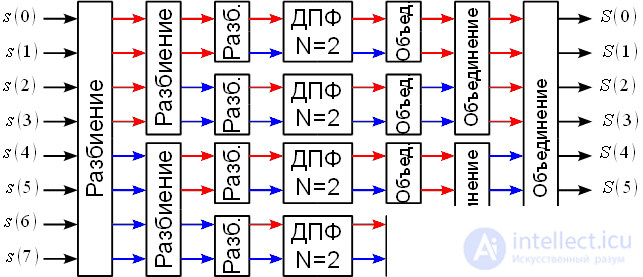
Figure 1: Splitting and combining sequences with N = 8
Split the original sequence by thinning time
To begin with, the complex exponent in expression (1) is denoted as:
 | (2) |
Then the expression (1) takes the form:
 | (3) |
Thinning time consists in splitting the original sequence of samples

,

in two sequences of duration


and

,

such that

, but

,

. In other words, the sequence

contains sequence counts

with even indices, and

- with odd ones. Thinning time for N = 8 is clearly shown in Figure 2.

Figure 2: Thinning time for N = 8
Consider the DFT signal thinned by time:
 | (four) |
If we consider only the first half of the spectrum

,

and also consider that
 , , | (five) |
then (4) can be written:
 | (6) |
Where

and

,

-

dotted DFT sequences of “even”

and "odd"

,

:
 | (7) |
And what did we get? Thinning in time can be considered an algorithm for splitting a sequence into two half-lengths. The first half of the combined spectrum is the sum of the spectrum of the “even” sequence and the spectrum of the “odd” sequence multiplied by the coefficients

which are called rotational coefficients.
Merge procedure. Count "Butterfly"
Now consider the second half of the spectrum

,

:
 | (eight) |
Consider the multiplier in more detail.
 . . | (9) |
Consider that
 , , | (ten) |
then expression (10) is true for any integer

, then (9) can be written taking into account (10):
 . . | (eleven) |
Consider now the turning factor in (8):
 . . | (12) |
Then the expression (8) in view of (11) and (12) takes the form:
 | (13) |
Thus, we can finally write down:
 | (14) |
Expression (14) is a combination algorithm for thinning by time. This merging procedure can be represented as a graph (Figure 3), which is called “Butterfly”.

Figure 3: Combining procedure based on the “Butterfly” graph
Graph FFT algorithm with thinning by time. Binary inverse permutation
We represent in the form of a graph an FFT algorithm with decimation in time based on a partitioning - a combination with

(picture 1).
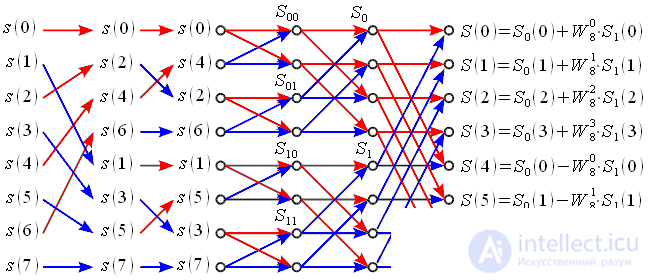
Figure 4: Graph of the FFT algorithm with thinning by time with N = 8
At the first stage, the input signal samples are interchanged and the initial sequence is divided into “even” and “odd sequences” (indicated by red and blue arrows). Then the “even” and “odd” sequences are in turn divided into “even” and “odd” sequences. With

such a division can be done

time. In our case

. This procedure is called binary-inverse permutation, so you can renumber the samples by rewriting the reference number in the binary system in the opposite direction. for example

has an index in decimal

, if

rewrite from right to left then we get

, i.e

after splitting into even odd before the first operation "Butterfly" will be in place

which in turn will fall into place

. By a similar rule, all counts will be swapped, while some will remain in place, in particular

as if

rewrite right to left it will still

similarly


and

. It is very important to understand that this renumbering method should be used when writing a number in a binary system consisting of

discharges. In the above example, 3 bits of the binary number were used, but if

(

) then it is necessary to write the number when using 4 digits. In this case

and after rewriting we get

that is, when


will not remain in place but will be swapped with

.
It can be said that directly binary-inverse permutation is convenient when the number of samples of the input signal is fixed in advance, however, in universal algorithms of FFT for various sizes

, binary inverse permutation is not effective, it is easier and faster to swap samples.
After a binary-inverse permutation, we obtain four 2-point DFTs:
 | (15) |
Based on four 2-point DFTs, two 4-point DFTs are formed:
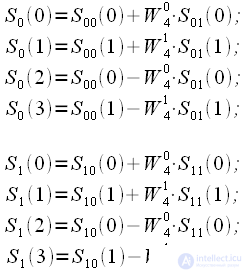 | (sixteen) |
And at the last level the full spectrum of the input signal is formed.
Turn factors
Consider in more detail the turning factors

.
At the first level (expression (15)), only one rotation coefficient is required.

This means that at the first level of the calculation of the spectrum, multiplication operations are not required (multiplication by

are called trivial, since when multiplied by

the multiplier remains the same or changes its sign to the opposite).
At the second level, we have two turning factors:
 | (17) |
Multiplication by an imaginary unit can also be considered trivial, since the real and imaginary parts of a complex number simply change places and change their sign.
At the third level, we already have 4 turning factors:
 | (18) |
Graphically, the steering factors can be represented as vectors on the complex plane:
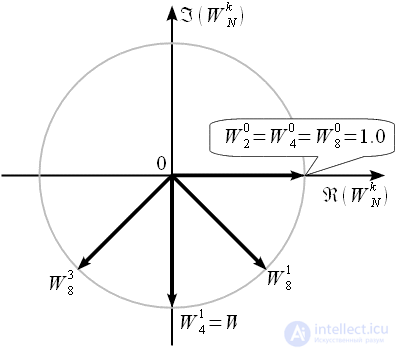
Figure 5: The rotational coefficients of the FFT algorithm with decimation time at N = 8
It can be noted that at all levels of unification the number of pivot coefficients doubles, with all the pivot coefficients of the previous level of unification being present at the next level. Thus, in order to move to the next level, it is necessary to insert the next factors between the rotation coefficients of the current level. Graphically, to go to the next level with N = 16, you need to supplement Figure 5 as shown in Figure 6. Gray vectors show the turning factors that will be present at the last level when

which are not with

.
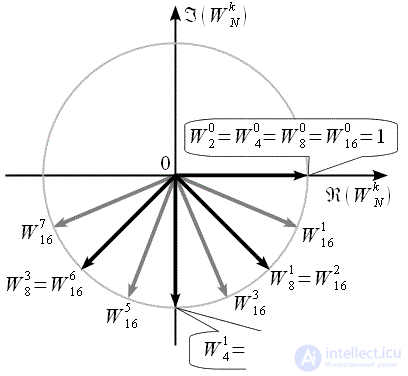
Figure 6: The rotational coefficients of the FFT algorithm with decimation in time at N = 16
It should also be noted that all rotational factors with the exception of zero

are in the lower half-plane of the complex plane.
Computational efficiency of time thinning FFT algorithm
The time thinning algorithm at each level requires

complex multiplications and additions. With

the number of levels of decomposition - the union is

so the total number of multiply and add operations is

.
Consider how many times the FFT algorithm with thinning in time is more efficient than the DFT. To do this, consider the acceleration factor

the ratio of the number of complex multiplication and additions using DFT and FFT, while taking into account that

:
 time. time. | (nineteen) |
The table below shows the required number of operations.

for the DFT algorithm for different

and when using FFT with thinning on time.
 | four | 6 | eight | ten | 12 |
 | sixteen | 64 | 256 | 1024 | 4096 |
 DFT DFT | 256 | 4096 | 65536 | 1048576 | 16777216 |
 FFT FFT | 64 | 384 | 2048 | 10240 | 49152 |
 time time | four | 10.7 | 32 | 102.4 | 341 |
The table clearly shows that the use of FFT leads to a significant reduction in the required number of computational operations. So for example when

FFT requires 100 times fewer operations than DFT, and with

341 times! The first publication of these results had the effect of a bombshell, rocking the entire scientific community. At the same time, it is very important that the gain in performance is the greater, the larger the sample size

. So for example when

the gain will be

time.
findings
Thus, in order to obtain an effective FFT algorithm for a base 2 with decimation time, with

it is necessary:
Carry out the binary-inverse permutation of the samples of the input signal, thereby ensuring the splitting of the sequence.
Using the turn factors, make N / 2 operations “Butterfly” according to expression (14) to get the first combination
Repeat the “Butterfly” operation according to expression (14) to merge to the next level

times, also using turning factors.
At the output, we obtain the DFT of the input sequence.




 ,
,  in two sequences of duration
in two sequences of duration 
 and
and  ,
,  such that
such that  , but
, but  ,
,  . In other words, the sequence
. In other words, the sequence  contains sequence counts
contains sequence counts  with even indices, and
with even indices, and  - with odd ones. Thinning time for N = 8 is clearly shown in Figure 2.
- with odd ones. Thinning time for N = 8 is clearly shown in Figure 2. 

 ,
,  and also consider that
and also consider that  ,
, 
 and
and  ,
,  -
-  dotted DFT sequences of “even”
dotted DFT sequences of “even”  and "odd"
and "odd"  ,
,  :
: 
 which are called rotational coefficients.
which are called rotational coefficients.  ,
,  :
: 
 .
.  ,
,  , then (9) can be written taking into account (10):
, then (9) can be written taking into account (10):  .
.  .
. 


 (picture 1).
(picture 1). 
 such a division can be done
such a division can be done  time. In our case
time. In our case  . This procedure is called binary-inverse permutation, so you can renumber the samples by rewriting the reference number in the binary system in the opposite direction. for example
. This procedure is called binary-inverse permutation, so you can renumber the samples by rewriting the reference number in the binary system in the opposite direction. for example  has an index in decimal
has an index in decimal  , if
, if  rewrite from right to left then we get
rewrite from right to left then we get  , i.e
, i.e  after splitting into even odd before the first operation "Butterfly" will be in place
after splitting into even odd before the first operation "Butterfly" will be in place  which in turn will fall into place
which in turn will fall into place  . By a similar rule, all counts will be swapped, while some will remain in place, in particular
. By a similar rule, all counts will be swapped, while some will remain in place, in particular  as if
as if  rewrite right to left it will still
rewrite right to left it will still  similarly
similarly 
 and
and  . It is very important to understand that this renumbering method should be used when writing a number in a binary system consisting of
. It is very important to understand that this renumbering method should be used when writing a number in a binary system consisting of  discharges. In the above example, 3 bits of the binary number were used, but if
discharges. In the above example, 3 bits of the binary number were used, but if  (
(  ) then it is necessary to write the number when using 4 digits. In this case
) then it is necessary to write the number when using 4 digits. In this case  and after rewriting we get
and after rewriting we get  that is, when
that is, when 
 will not remain in place but will be swapped with
will not remain in place but will be swapped with  .
.  , binary inverse permutation is not effective, it is easier and faster to swap samples.
, binary inverse permutation is not effective, it is easier and faster to swap samples. 

 .
.  This means that at the first level of the calculation of the spectrum, multiplication operations are not required (multiplication by
This means that at the first level of the calculation of the spectrum, multiplication operations are not required (multiplication by  are called trivial, since when multiplied by
are called trivial, since when multiplied by  the multiplier remains the same or changes its sign to the opposite).
the multiplier remains the same or changes its sign to the opposite). 


 which are not with
which are not with  .
. 
 are in the lower half-plane of the complex plane.
are in the lower half-plane of the complex plane.  complex multiplications and additions. With
complex multiplications and additions. With  the number of levels of decomposition - the union is
the number of levels of decomposition - the union is  so the total number of multiply and add operations is
so the total number of multiply and add operations is  .
.  the ratio of the number of complex multiplication and additions using DFT and FFT, while taking into account that
the ratio of the number of complex multiplication and additions using DFT and FFT, while taking into account that  :
:  time.
time.  for the DFT algorithm for different
for the DFT algorithm for different  and when using FFT with thinning on time.
and when using FFT with thinning on time. 

 DFT
DFT  FFT
FFT  time
time  FFT requires 100 times fewer operations than DFT, and with
FFT requires 100 times fewer operations than DFT, and with  341 times! The first publication of these results had the effect of a bombshell, rocking the entire scientific community. At the same time, it is very important that the gain in performance is the greater, the larger the sample size
341 times! The first publication of these results had the effect of a bombshell, rocking the entire scientific community. At the same time, it is very important that the gain in performance is the greater, the larger the sample size  . So for example when
. So for example when  the gain will be
the gain will be  time.
time.  it is necessary:
it is necessary:  times, also using turning factors.
times, also using turning factors.
Comments
To leave a comment
Digital signal processing
Terms: Digital signal processing